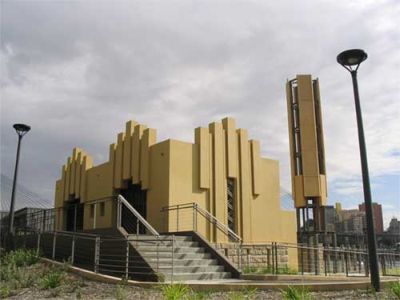In the 1960s, like the rest of the inner-Sydney Victorian ring, Glebe was viewed as a slum, ripe for demolition. Today it is a sought after residential suburb, with a range of accommodation from renovated terraces from the 1880-1890s to ultra-modern (and expensive) harbourside townhouses and apartments. The story of this transformation is not only a story of changing tastes and lifestyles, but also the story of a determined group of residents who saw the potential beauty and amenity of their suburb and fought to preserve it from the bulldozers.
The Harold Park site is the largest development in Glebe in the past ten years, and has been the subject of continuing interest and involvement by the Glebe Society. The Society’s position, developed through an extensive process of consultation with members and the broader community, is set out in documents below.
New Town PlanThe Sydney City Council in late 2005 began writing a new city plan, and Glebe is one of the first areas to be considered. An important part of this process is an urban design study that examines how the built environment works for the local community to create our living environment. On November 23, the City Council ran a workshop at Glebe Town Hall designed to elicit input from residents. Opening the workshop, the Lord Mayor, Cr Clover Moore, said: “These workshops are your opportunity to tell us about the built form of your area and discuss what you think works and what doesn’t. We will be focusing on the local level, on issues such as life style and type of development, density and heights. Your input will help guide our planners to make recommendations on core planning controls like Floor Space Ratio and height. “This is also just one part of the City Plan process. We will be undertaking separate studies and community consultation on heritage to ensure strong and effective heritage controls to maintain the distinctive heritage of the Glebe area.” Click here to read Planning Convenor Neil Macindoe’s report on progress with aspects of the new city plan in his Bulletin column (April, 2006) Click here to access the City Council’s website that explains the process that will lead to the development of the new city plan. |

Picture: Adrienne Kabos, WBG Society
The development and application of appropriate planning controls was fundamental to the successes achieved by the founders of The Glebe Society, and continues to be one the most important aspects of the Society’s work.
Development Application Process
The Society monitors development applications being considered by the Sydney City Council, and other development activities, and lodges objections to developments that it considers are not in the best interests of the area.
Development applications are usually available for public comment for two weeks. Members should send their comments direct to the Council, or e-mail comments to the Planning Convenor.
It should be remembered that commenting on DAs forms only a small part of the Planning matters affecting our suburb. Glebe’s status as a Conservation Area and our heritage issues are of paramount importance to The Glebe Society Inc
Ensuring that Glebe is conserved and recognised as a heritage area was one of the key issues identified by the Society for action as part of our strategic planning process.
Priorities were the removal of eyesores, the restoration/ conservation of heritage buildings and structures of interest and improving the visual integrity of the streetscape.
The Society continues to be ever vigilant about the sensitive and pragmatic approaches to the conservation of heritage sites in our community and thus maintains an active role as a ‘watchdog’ on all DAs affecting Glebe. This is a very important and on-going commitment.
Posted for Neil Macindoe
Posted on 14th April 2009









There are no comments yet. Please leave yours.